Also available:
The Beer Token [Video]
This post is also available as an article. So if you'd rather read a conventional blog post of this content, you can!
This post is also available as an article. So if you'd rather read a conventional blog post of this content, you can!
This post is also available as a podcast. Listen here, download for later, or subscribe wherever you consume podcasts.
This post is also available as a video. If you'd prefer to watch/listen to me talk about this topic, give it a look.
The novelisation of The Hitch-Hiker’s Guide to the Galaxy came out in 1979, just a smidge before I was born. There’s a well-known scene in the second chapter featuring Ford Prefect, an alien living on Earth, distracting his human friend Arthur Dent. Arthur is concerned about the imminent demolition of his house by a wrecking crew, and Ford takes him to the pub to get him drunk, in anticipation of the pair attempting to hitch a lift on an orbiting spacecraft that’s about to destroy the planet:
“Six pints of bitter,” said Ford Prefect to the barman of the Horse and Groom. “And quickly please, the world’s about to end.”
The barman of the Horse and Groom didn’t deserve this sort of treatment, he was a dignified old man. He pushed his glasses up his nose and blinked at Ford Prefect. Ford ignored him and stared out of the window, so the barman looked instead at Arthur who shrugged helplessly and said nothing.
So the barman said, “Oh yes sir? Nice weather for it,” and started pulling pints.
He tried again.
“Going to watch the match this afternoon then?”
Ford glanced round at him.
“No, no point,” he said, and looked back out of the window.
“What’s that, foregone conclusion then you reckon sir?” said the barman. “Arsenal without a chance?”
“No, no,” said Ford, “it’s just that the world’s about to end.”
“Oh yes sir, so you said,” said the barman, looking over his glasses this time at Arthur. “Lucky escape for Arsenal if it did.”
Ford looked back at him, genuinely surprised.
“No, not really,” he said. He frowned.
The barman breathed in heavily. “There you are sir, six pints,” he said.
Arthur smiled at him wanly and shrugged again. He turned and smiled wanly at the rest of the pub just in case any of them had heard what was going on.
None of them had, and none of them could understand what he was smiling at them for.
A man sitting next to Ford at the bar looked at the two men, looked at the six pints, did a swift burst of mental arithmetic, arrived at an answer he liked and grinned a stupid hopeful grin at them.
“Get off,” said Ford, “They’re ours,” giving him a look that would have an Algolian Suntiger get on with what it was doing.
Ford slapped a five-pound note on the bar. He said, “Keep the change.”
“What, from a fiver? Thank you sir.”
There’s a few great jokes there, but I’m interested in the final line. Ford buys six pints of bitter, pays with a five-pound note, and says “keep the change”, which surprises the barman. Presumably this is as a result of Ford’s perceived generosity… though of course what’s really happening is that Ford has no use for Earth money any longer; this point is hammered home for the barman and nearby patrons when Ford later buys four packets of peanuts, also asking the barman to keep the change from a fiver.
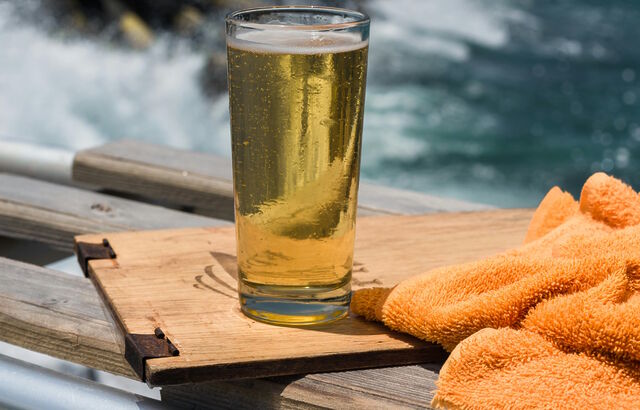
We’re never told exactly what the barman would have charged Ford. But looking at the history of average UK beer prices and assuming that the story is set in 1979, we can assume that the pints will have been around 34p each1, so around £2.04 for six of them. So… Ford left a 194% tip for the beer2.
By the time I first read Hitch-Hikers, around 1990, this joke was already dated. By then, an average pint of bitter would set you back £1.10. I didn’t have a good awareness of that, being as I was well-underage to be buying myself alcohol! But I clearly had enough of an awareness that my dad took the time to explain the joke… that is, to point out that when the story was written (and is presumably set), six pints would cost less than half of five pounds.
But by the mid-nineties, when I’d found a friend group who were also familiar with the Hitch-Hikers… series, we’d joke about it. Like pointing out that by then if you told the barman to keep the change from £5 after buying six pints, the reason he’d express surprise wouldn’t be because you’d overpaid…
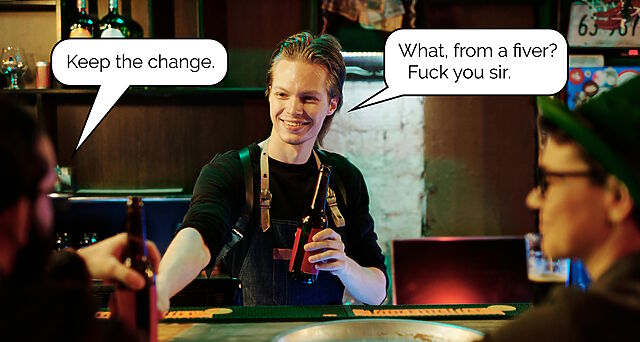
Precocious drinker that I was, by the late nineties I was quite aware of the (financial) cost of drinking.
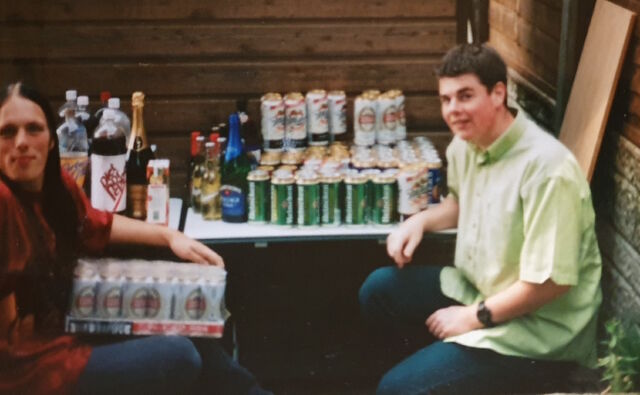
And so when it was announced that a new denomination of coin – the £2 coin – would enter general circulation3 I was pleased to announce how sporting it was of the government to release a “beer token”.
With the average pint of beer at the time costing around £1.90 and a still cash-dominated economy, the “beer token” was perfect! And in my case, it lasted: the bars I was drinking at in the late 1990s were in the impoverished North, and were soon replaced with studenty bars on the West coast of Wales, both of which allowed the price of a pint to do battle with inflationary forces for longer than might have been expected elsewhere in the country. The “beer token” that was the £2 coin was a joke that kept on giving for some time.
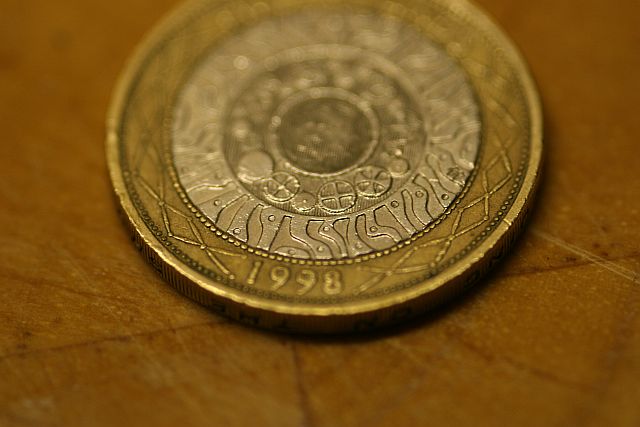
As the cost of living rapidly increased circa 2023, the average price of a pint of beer in the UK finally got to the point where, rounded to the nearest whole pound, it was closer to £5 than it is to £44.
And while we could moan and complain about how much things cost nowadays, I’d prefer to see this as an opportunity. An opportunity for a new beer token: a general-release of the £5 coin. We already some defined characteristics that fit: a large, heavy coin, about twice the weight of the £2 coin, with a copper/nickel lustre and struck from engravings with thick, clear lines.
And the design basically comes up with itself. I give you… the Beer Token of the 2020s:
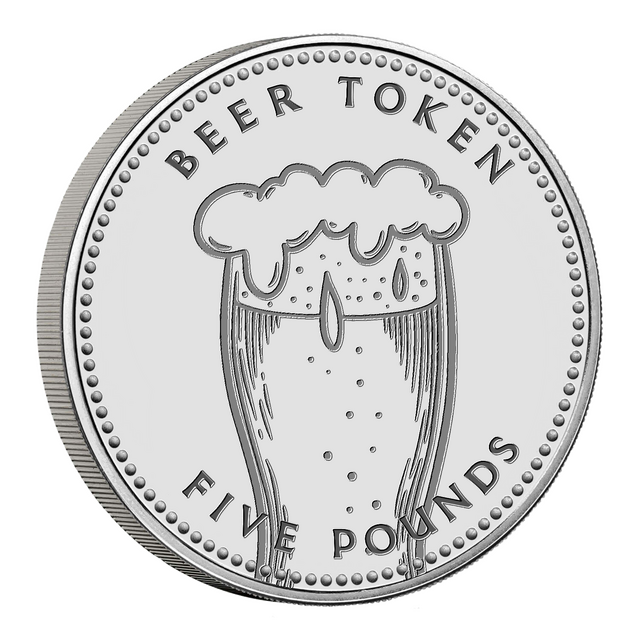
It’s time for the beer token to return, in the form of the £5 coin. Now is the time… now is the last time, probably… before cash becomes such a rarity that little thought is evermore given to the intersection of its design and utility. And compared to a coin that celebrates industry while simultaneously representing a disfunctional machine, this is a coin that Brits could actually be proud of. It’s a coin that tourists would love to take home with them, creating a satisfying new level of demand for the sinking British Pound that might, just might, prop up the economy a little, just as here at home they support those who prop up the bar.
I know there must be a politician out there who’s ready to stand up and call for this new coin. My only fear is that it’s Nigel Fucking Farage… at which point I’d be morally compelled to reject my own proposal.
But for now, I think I’ll have another drink.
1 The recession of the 1970s brought high inflation that caused the price of beer to rocket, pretty much tripling in price over the course of the decade. Probably Douglas Adams didn’t anticipate that it’d more-than-double again over the course of the 1980s before finally slowing down somewhat… at least until tax changes in 2003 and the aftermath of the 2022 inflation rate spike!
2 We do know that the four packets of peanuts Ford bought later were priced at 7p each, so his tip on that transaction was a massive 1,686%: little wonder the barman suddenly started taking more-seriously Ford’s claims about the imminent end of the world!
3 There were commemorative £2 coins of a monometallic design floating around already, of course, but – being collectible – these weren’t usually found in circulation, so I’m ignoring them.
4 Otherwise known as “two beer tokens”, of course. As in “Bloody hell, 2022, why does a pint of draught cost two beer tokens now?”
It’s been a long day of driving around Ireland, scrambling through forests, navigating to a hashpoint, exploring a medieval castle, dodging the rain, finding a series of geocaches, getting lost up a hill in the dark, and generally having a kickass time with one of my very favourite people on this earth: my mum.
And now it’s time for a long soak in a hot bath with a pint of the black stuff and my RSS reader for company. A perfect finish.
This is a repost promoting content originally published elsewhere. See more things Dan's reposted.
My dinner-party party piece for many years was to say, “Well, actually, I invented Baileys. You know, Baileys Irish Cream. I did that back in 1973.”
If one of the unfortunate listening group is a woman – and this is based on actual past experience – she is likely to respond something like this: “Oh-my-God. Baileys. My mother absolutely adores it. Did you hear that, Jocasta? This man invented Baileys. It’s unreal. I don’t believe it. He must be terribly rich. Baileys Cream. Wow!”
And it’s not as if these rather posh people really adore Baileys. Or even hold it in the same esteem as, say, an obscure Islay single malt or a fine white burgundy from Meursault. Not a bit of it. They might have respected it years ago but most people of legal drinking age regard Baileys as a bit naff. To my mind, they’d be very wrong…
Despite a full workload and a backlog of both work, personal, volunteering and study emails to deal with, 2016 is off to a pretty good start so far. Here’s some highlights:

I hope everybody else’s year is kicking off just as well.
* With one possible exception: the other year, an overenthusiastic bouncer insisted that I join a queue of one in turn to show him my ID before he let me into a nightclub at 9:30pm on a Wednesday night. Like I said, overenthusiastic.
This is a repost promoting content originally published elsewhere. See more things Dan's reposted.
You will be shocked to hear that, according to a new report in the journal Addiction, the UK government’s drinking guidelines are incompatible with the UK’s drinking habits. Solving the problem might lie in a counterintuitive update: accepting the reality of binge drinking…
The entire infrastructure of our civilization – our entire species – is something that you can’t help but take for granted. Let’s make a cheese & pickle sandwich.
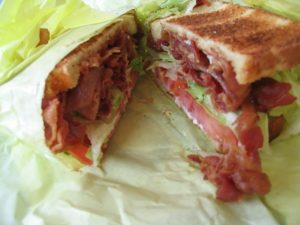
Find a grass whose seed, when crushed, yields a powdery flour rich in carbohydrates and proteins – any of the dozens of species of wheat will do, but there are plenty others besides. If you’re genuinely starting from scratch, you might find that it’s first worth your while cultivating and selectively breeding the cereal to improve its yield. Separate off the dry outer chaff from the seeds and grind them. You’ll also need some yeast, which you can acquire from the environment by letting water in which you’ve boiled vegetables sit in the warm for a few days, or by extracting it from the skins of fruits: alternatively, you can make use of yeast spores in the atmosphere by working slowly in the vicinity of fermenting sugars; e.g. somebody brewing alcohol. Combine the flour with some water and the yeast to make a dough, let it rise, then put it in a hot box for a while to bake it. There’s your bread.
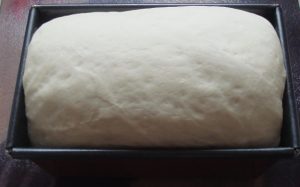
Meanwhile, domesticate some cattle. You’ll need to have started this quite a while earlier. Specifically, you’re going to need cows that have recently weaned a calf, so they’re still lactating. Manipulate the teats of the cow to extract its milk, then heat it gently while stirring it. Assuming that you don’t have the resources to identify and separate lactococcus bacteria, you’ll want to be careful not to heat the milk enough that it kills any such bacteria already in it. Add an edible acid (lemon juice will do, assuming you’ve got access to lemons; alternatively you could use vinegar, which you’ll be needing later on anyway) to cause the milk to begin separating into curds (the solid part) and whey (the liquid part) – alternatively, if you’ve got spare unweaned calves that you can kill and harvest the stomachs of, you can use rennet. If you’ve got the hang of processing cotton, you can weave yourself a square of cheesecloth and use this as a filter. Once you’ve reduced the curds as far as possible, wrap it and squeeze it in a press (you can make this by putting weight on it) for a few days, turning occasionally. Then, cover it in an airtight seal of wax (you can get this by melting honeycombs taken from a beehive), and leave it for a month or two. There’s your cheese.

Harvest some fruit and vegetables, such as – depending on availability – swede, carrots, dates, onions, cauliflower, apples, courgettes, and tomatoes, and dice them. Boil together in vinegar with cloves, mustard, and sugar added until the hardest parts (typically the swede) are firm but not crunchy. Heat a sterile, airtight container, add the mixture, and seal. Leave for a couple of weeks. Oh: you don’t have vinegar? No problem: first you’re going to need alcohol, which you can produce from fruit – apples are probably easiest; grapes are another popular choice – and yeast: just combine the two and give it a few weeks. Now, to turn that into vinegar, keep it at just over room temperature for several more weeks, stirring regularly to aerate it. Seriously: if you thought that learning to milk a cow was hard, you should have given up long before now. Anyway: there’s your pickle.
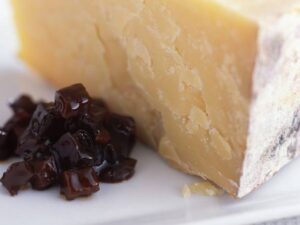
You’ll also want some butter, but by this point you’re used to a little work. Assuming you don’t have access to a centrifuge, the traditional thing to do next is to leave it sitting in a shallow pan for about 24 hours, then skimming off the top – congratulations, you’ve got cream (the remaining milk is now what you would call skimmed milk; I suggest you have yourself a cool glass of it while you start working on the next bit). Put the cream into a bowl with a pinch of salt and work it, keeping it as cool as possible while you do so, as if you were trying to make whipped cream… but keep going! If you whip it for long enough it’ll gradually become more and more solid: drain it of the excess liquid (this is buttermilk), and then form it into a ball or block. Hurrah: you’ve got butter!

Finally, you can assemble your sandwich. Slide the bread, spread butter onto the slices, and put slices of the cheese and a spoonful of pickle in between them. That wasn’t so hard, now, was it?
You’ll be forgiven if you’re wondering why I’ve just shared with you the most drawn-out recipe imaginable, for something so simple as a cheese & pickle sandwich.
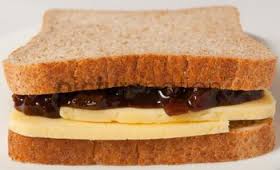
It’s just this: think about how much was involved in that process (and I didn’t even talk about making the tools you’d need). How complex is that process, compared to everything eaten by every other animal on the planet. Otters use rocks to get into shellfish, and chimpanzees use sticks to pull termites out of nests, but apart from these – and a few other exceptions – virtually no other species we’ve ever come across does anything more than picking or hunting for their food, and then eating it. We, on the other hand – even for our simplest processed foods – put a monumental amount of effort into making them the way they are.
And as if that weren’t complex enough, we go even further. We make different kinds of bread and cheese with different kinds of flour and milk, different processes, different ages; we make different brands of pickle and butter, and then argue on the Internet about which one is the best. We make sandwiches with egg mayonnaise (boiled eggs… in an emulsion of egg yolks and oil), with roasted or cured meats of different kinds of animals, with hummus (a remarkably complicated ingredient in its own right).
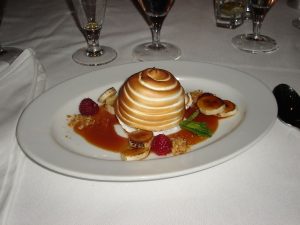
When you make yourself a sandwich, you’re standing upon the shoulders of the hundreds of generations that preceded you, and all of their peers. A collective knowledge passed down over millennia. In reality, nobody milks a cow because they want to make a sandwich: but that separation is only possible because of the enormous infrastructure we’ve built up in order to support the production and distribution of dairy goods.
We are, indeed, a very strange species.
But if you actually do have a go at making a sandwich based on this recipe, let me know how you get on.
This post turned out longer than I expected. The first part is about comedy, whisky tasting, and a museum full of money. The second part is about how we were “outed” as being in a nonmonogamous relationship, and how it went really well. Click either link to jump to that section, or just start reading to get the whole thing.
Our sixth day at Edinburgh was perhaps the booziest. Realising that we still had a significant amount of wine that we bought earlier in the week that we hadn’t yet consumed, we started early: Ruth and I poured our first glasses at a hair before 11am, to go with our breakfast.

Our first show of the day was Sam Brady and the Eight Worldly Winds, a beautiful and subtle piece of observational comedy based on the life of the comedian, a “failed Buddhist monk”, thrice married, interspersed with “mildly adapted” readings of 11th century Chinese poetry. It was sedate and relaxing, as comedy shows go, but still funny and enjoyable, and I could have happily have listened to him for longer.
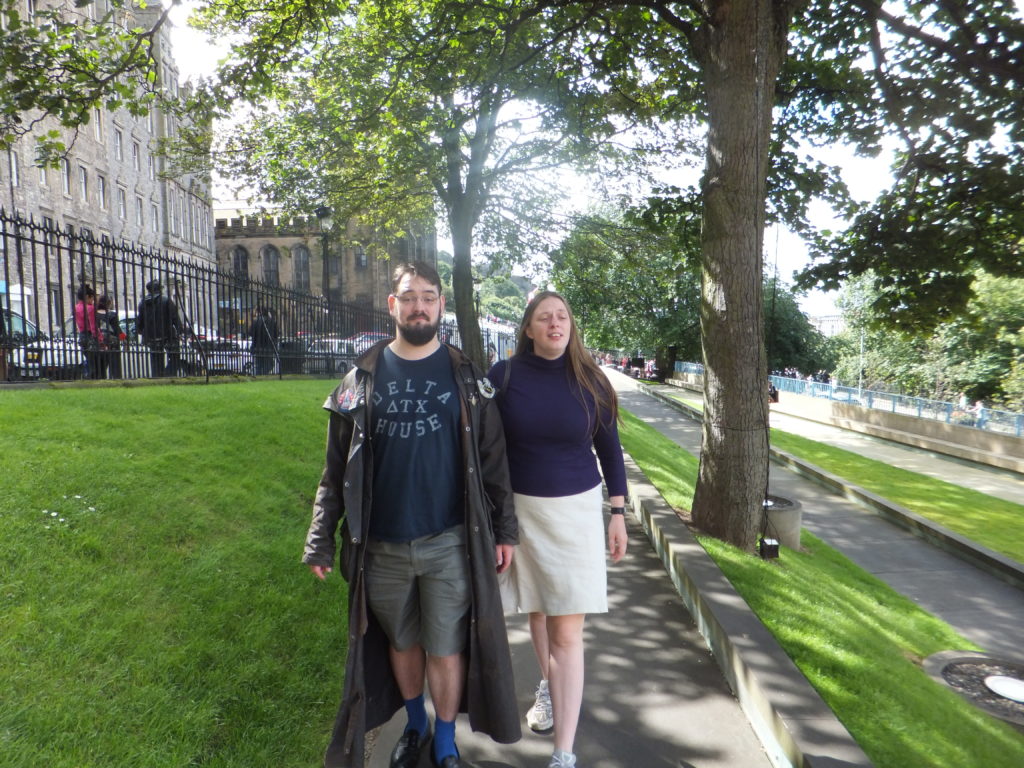
We had a little while before the next item on our schedule, and we opted to divert from our original plan to waste half an hour in a bar to instead explore the Mus£um On The Mound. This museum chronicles the history of money and banking, with a special focus on Scotland, and it’s remarkably interesting. We learned about early banking computers, quality assurance processes in banknote printing, and the evolution of the Building Society. If you think that all sounds terribly dull, then screw you.
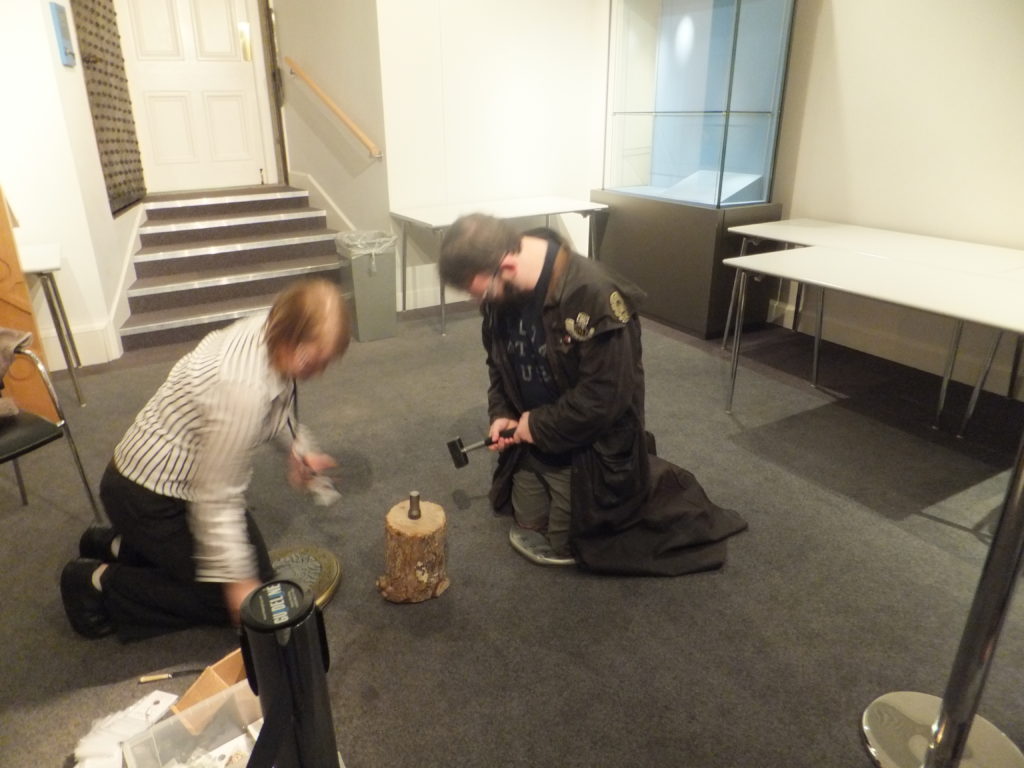
JTA tried his hand at striking faces onto metal disks to make his own coins in the way that coinsmiths used to before about the 16th century, and I used a remarkably modern-looking computer to issue myself a remarkably old-style life insurance certificate (covering me for everything except death by duelling, suicide, or execution by the state).

Next, we made our way back to the Whiski Rooms for our second whisky tasting session of the week (our first was on day two). This time around we were drinking Jura (10 year old and 16 year old, and Superstition – one of my favourites) and Dalmore (12, 15, and 18 year old). We learned a lot about the different production processes for each, caskings and recaskings and still shapes and all kinds of things. We also tried the Dalmore 15 with some orange chocolate that complemented one another very well, and tried our hand at identifying different refined flavours by smell, from a set of numbered vials.

Next up, we watched The German Comedian (exactly what it says on the tin!), followed by You Are
Being Lied To, by David Mulholland. The former provided a hilariously funny (and somewhat racist, although only in a very tongue-in-cheek and mostly in a self-deprecating way)
commentary on European relations, world travel, and cultural differences in a brilliant and compelling way. The latter – by a comic who was formerly a journalist for the Wall Street
Journal – ran a show with a far more serious message, about how media like The Daily Mail, The Sun, and The Telegraph (in particular) spin stories in a way that the kernel of truth in
them is just about impossible to find. It was amusing enough, especially to hear him read, in a serious voice, genuine headlines and snippets of stories from those publications, and let
us spot the bullshit.

The other thing that was remarkable about these two comedians is that they both independently asked about Ruth, JTA and I’s relationship structure. And what’s most remarkable about this is that it took so long before it happened. We’ve been here six days, at dozens of different comedy shows, and virtually always sat at the front. But today was the first day that the topic came up, and it came up twice in a row. What are the odds?

The first comedian had asked if Ruth and JTA were a couple, and, upon getting an affirmative (which would usually be as far as the conversation would go: we’re not in the business of hijacking comedy shows with our relationships, I’d hasten to add), he asked “What’s the relationship between you two?”, gesturing to Ruth and I. So we answered. He asked for clarification a number of times, looking quite stumped and lost for words the whole period, but he was fluffy about it in general, which was nice.
The second really did just walk into it when he asked Ruth “So which of these two men are you with? Or is it both?” “Yes, both,” she replied, and, in the period of silence while the comedian was still trying to comprehend what she’d said, added, “We’re polyamorous.”
I was so very proud of her in that moment.
For me, adopting the out and proud approach of the gay community is an important part of “poly activism”: it almost feels like it’s my duty to make sure that people can see that we’re just another group of people in just another relationship, completely normal except for the fact that there are three of us instead of two. Talking openly and frankly about this stuff is the only way to normalise it and break the taboo, so I feel like my mini-activism helps all people in nonmonogamous relationships, even if just a little bit.

Ruth, however, is more-reserved, and less-inclined to put herself in the public spotlight by putting the fact that she’s got a “bonus” partner “out there”. So to see her take the lead in saying, effectively, “Yes; I have two partners. Here they are. Yes, really. Is that okay?” – especially when she was sat sandwiched between a room full of strangers and a comedian (a very precarious place, as anybody who’s been picked on by a comic knows) – made my heart swell.
Later, a man called Daniel asked me some reasonably well-thought-out questions about “how it works”, and Ruth and JTA were approached by a woman who mentioned a similar arrangement in her own life. People in the same position are often delighted to “come out”, but only if somebody else does so first.
Had it been me that each comedian had spoken to first, instead of Ruth, I’d have certainly been as bold. But I might not have simultaneously been so frank and straightforward, so clearly-honest and approachable as Ruth managed in this, one of the most brave acts of poly-advocacy I’ve ever seen.
Nice work, Ruth.
Our second day at the Edinburgh Fringe brought new opportunities for fun and merriment. Once we finally dragged ourselves from our beds.

First up, we insisted that Matt joined us in watching the show of Young & Strange, a talented pair of magicians we first saw earlier this year, at the Oxford Fringe. Their act wasn’t quite so magical on a second viewing, and some of their tricks wear thin on the closer-inspection made possible by the tiny venue and the orientation of the lights, but they’re still remarkable showmen and real masters of their craft. Matt was invited on stage to assist with a trick involving separating all of the different denominations of currency into twelve numbered envelopes (1p, 2p, 5p, 10p, 20p, 50p, £1, £2, £5, £10, £20, £50). I tell you this because it’ll be relevant in a subsequent blog post. Seriously.

Later, we watched the incredibly disappointing Computer Programmer Extraordinaire, by comedian Raph Shirley. For all of his good ideas (and he certainly had enough of them to fill a 15 minute set, but 45 minutes seemed like far too long), his delivery was sorely lacking. Maybe we went in expecting something that we wouldn’t get – his “geeky” computer programmer persona didn’t really cut it for those of us who were genuine geeky computer programmers in the audience – but even if we put that aside, there weren’t enough laughs in the show to have been worth the time it took to “get there”, even at no cost.

Ruth, JTA and I then disappeared off to Whiski Rooms for a “Whisky & Cheese Tasting” event. This was really quite enjoyable, and I was surprised to be able to, under a little guidance (and with the inclination to pay particular attention to the subtler facets of what I was drinking), find entirely new flavours even in whiskies with which I was already familiar. Pairing whiskies with cheeses was also a new experience for me, and – even for somebody like me, who enjoys cheese in moderation but doesn’t have the palate for the full spectrum of cheeses – provided some fascinating opportunities to find new flavours.*

This – coupled with the drinks we’d already had and those we had later – left us rather tipsy. Although thankfully still nowhere near as drunk as Claire was, here in Edinburgh, when six years ago she did the most embarrassing thing in the world.

Finally, we reconvened with Matt for a dose of Peter Buckley Hill And Some Comedians. I don’t remember his name, but I was particularly impressed with the dry, deadpan delivery of the dutch comedian. If it comes back to me, I’ll come back and write his name in here: ____________________. Look, I’ve left a nice long gap and everything.
* For anybody who’s interested, the whiskies we tried (and the cheeses they were paired with) were: Tobermory 10 with Keens Cheddar; Jura Superstition with Old Smokey; Bruichladdich 10 with Adrahan; and Bowmore 12 with Dunsyre Blue.
This link was originally posted to /r/funny. See more things from Dan's Reddit account.
The original link was: http://i.imgur.com/Fp1LB.jpg
It feels like most of the time I’ve spent in a car this year, so far, has been for travel related to somebody’s recent death. And so it was that yesterday, Ruth, JTA and I zipped up and down the motorway to attend the funeral of Ruth’s grandmother.
It went really well, but what I wanted to share with you today was two photos that I took at service stations along the the way.

This one confuses me a lot. If I buy alcohol from this service area, I can’t drink it either inside… or outside… the premises. Are they unlicensed, perhaps, and so the only way they’re allowed to sell us alcohol is if we promise not to drink it? Or is it perhaps the case that they expect us only to consume it when we’re in a parallel dimension?

It’s hard to see in the second photo without clicking (to see it in large-o-vision), but the sign on the opposite wall in this Costa Coffee implies the possibility of being an “Americano Addict”. And there was something about that particular marketing tack that made me cringe.
Imagine that this was not a café but a bar, and substitute the names of coffees with the names of alcoholic beverages. Would it be cool to advertise your products to the “wine addicts” or the “beer addicts” of the world? No: because alcoholism isn’t hip and funny… but caffeine addiction is? Let’s not forget that caffiene is among the most-addictive drugs in the world. Sure, caffeine addiction won’t wreck your liver like alcohol will or give you cancer like smoking tobacco (the most-popular way to consume nicotine) will, but that doesn’t detract from the fact that there are many people for whom a dependency upon caffeine is a very real part of their everyday life.
Is it really okay to make light of this by using such a strong word as “addict” in Costa’s marketing? Even if we’re sticking with alliteration to fit in with the rest of their marketing, wouldn’t “admirer” or “aficionado” be better? And at least that way, Costa wouldn’t leave me with a bitter taste in my mouth.